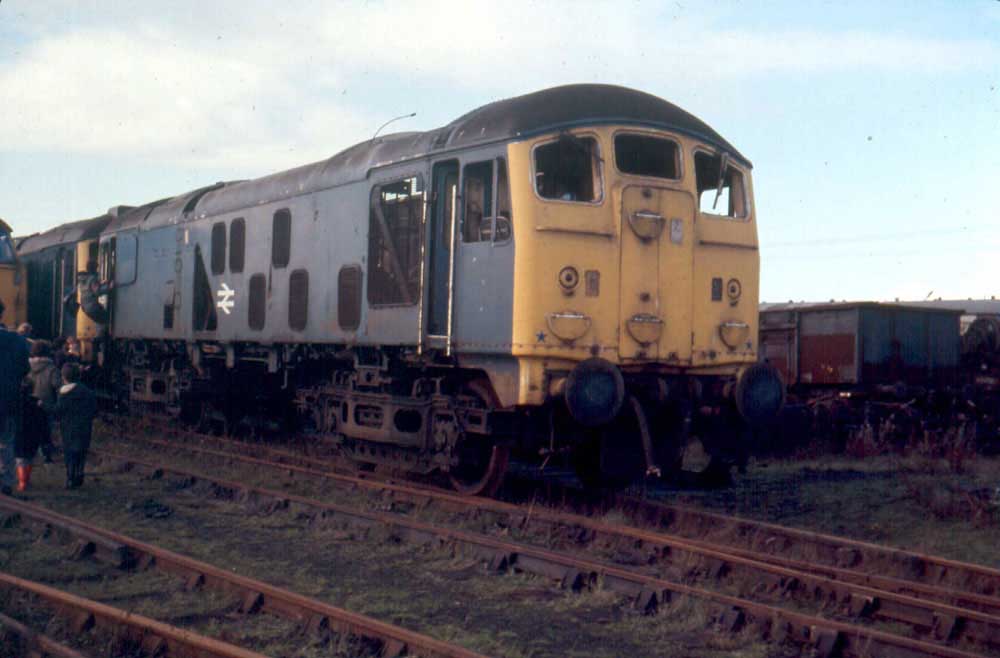I don't know what it is about the attraction that scrapyards provide to many of us. Perhaps it is the unexpected chaos of such places, contrasted against the well oiled machine that the railways normally presented (well most of the time!). Or perhaps it was around the scrapyards that many long forgotten memories were/are invoked, of favourite locomotives remembered from much better times (those rose tinted glasses again!). Or it simply could be that its much more fun to take something apart, especially if cutting torches and sledge hammers are involved.
Hopefully you won't mind the inclusion of views depicting locomotives other than the Class 24/25's. The initial idea was just to include the Sulzer powered locomotives that ended their days at the various Railway Workshops, but in wandering through my own photohraphs and of those acquired from others over the years it seemed a pity not to include the other classes that were scrapped alongside the Sulzer powered locomotives.
![]()
Derby Works
Any photographs that were originally included on these pages at Derby Works have since been transferred to the pages that take a close look at Derby Works.
![]()
Swindon Works
Since most of the organised visits to Swindon Works took place on a Sunday this was not the easiest place to get to by rail from Derby when having to take into account the challenges of Sunday timetabling and the ever present engineering works. It was not until a driver's license and a car were available that Swindon Works became more easily visited. I've probably forgotten how many times we ran up and down the A38, A452, A46, A429 & A361 on these trips, and probably a few other routes when we got lost or diverted!
My first recorded visit to Swindon appears to have been on a cloudy November 6th 1976 when the Works contained many Class 52 Westerns and some Class 24's. Like most trips to the Works it started out by going through a gateway, under the mainlines and then up alongside one of the main shop buildings before entering the main erecting shop area. Swindon's workload at this time focused on diesel multiple units, refurbishing of Southern Region electric multiple units, Class 03 & 08 overhauls and repairs to hauled stock. After passing through the erecting shops it would be out into the yards where much stock and locomotives could be found, usually awaiting scrapping. Then it was back through the areas that looked after the diesel multiple unit repairs/refurbishings
November 7th 1976
Although mostly an overcast day the sun did shine whilst we were in the erecting shops, giving a little extra light to the view below. Also present in the erecting shop and probably ignored by most was Vale of Rheidol No.9 Prince of Wales, probably the oldest piece of active rolling stock in Works at that time.


Out in the yards the sun did break through the clouds to provide a little extra light every now & then.





In the above view the indicator blind on the front of the locomotive shows '72' which some (including your webmaster) may have taken to indicate that this locomotive was 1072 Western Glory. More learned enthusiasts would know that the locomotive in the photograph could not be 1072 because the photograph shows one of only five Westerns equipped with the experimental square ventilator grille on the cab front. These were 1012, 1028, 1039, 1056 & 1071. Additionally 1072 was only withdrawn on November 2nd 1976, five days before the photograph of 1012 was taken. Withdrawal for 1072 came at Bristol Bath Road and the locomotive was utilised at the end of November in the making of a safety film concerning rerailing. It would be towed away from Bristol on February 24th 1977 on its last journey - to Swindon Works.


In the above view is 25016, the last of the three ex-Tinsley allocation that had been stored at Barrow Hill for a while before being towed down to Swindon for scrapping. 25017 & 25020 had already been broken up, 25016 would be gone by year's end. Apart from the Class 25 the locomotives awaiting scrapping were all of Classes 24 & 52. Tucked away in the lines in the yard were the last two LMR examples of green liveried Class 24's: 24092 & 24136. On this day they were not parked in positions conducive to decent photographs, especially to highlight their faded green livery!


January 23rd 1977
The next trip to Swindon was on a truly overcast day, January 23rd 1977. The locomotives in the Works were still dominated by the withdrawn Class 24's & 52's. Vale of Rheidol No.9 was still present and PWM 652 had been recieved for repair.


March 7th 1978
Two views from Bryan Johnson from March 7th 1978 - it looks like Bryan had some good weather on this visit!

![]()
Page added September 18th 2001.
Page updated June 1st 2020.